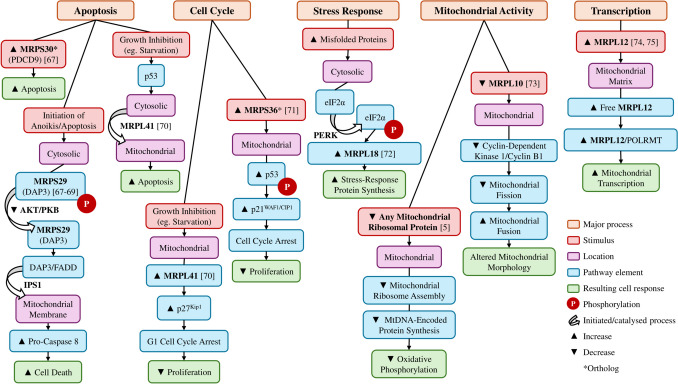Fig. 1.
Normal cellular functions involving mitochondrial ribosomal proteins. Mitochondrial ribosomal proteins are involved in a wide range of cellular functions and responses, from apoptosis, cell cycle arrest, and stress response pathways to mitochondrial function and transcription. Although poorly characterised in humans, an increase in MRPS30 ortholog in mice fibroblasts increases apoptosis [6]. Cytosolic MRPS29 assists in activating anoikis in detached cells, through the extrinsic cell death activation pathway [6–8]. When cells are exposed to environmental changes inhibiting cell growth, MRPL41 stabilises p53 and supports its translocation into the mitochondria, where it induces apoptosis [9]. Additionally, under conditions inhibiting cell growth, MRPL41 also suppresses proliferation through G1 cell cycle arrest [9]. An increase in the MRPS36 ortholog in mice has been observed to promote the phosphorylation of p53 to induce cell cycle arrest and suppress tumour growth [10]. Cytosolic MRPL18 is increased as part of the cytosolic stress response, this then promotes increased synthesis of stress-response proteins [11]. Mitochondrial ribosomal proteins are required for mitochondrial-DNA encoded protein synthesis, which is critical for functional oxidative phosphorylation [5]. Decreased MRPL10 has been shown to decrease cyclin B1/Cdk1 activity, resulting in mitochondrial clustering and elongation [12]. Free MRPL12 within the mitochondrial matrix binds to POLRMT, an RNA polymerase, to increase promoter-dependent and -independent mitochondrial transcription [13, 14]

